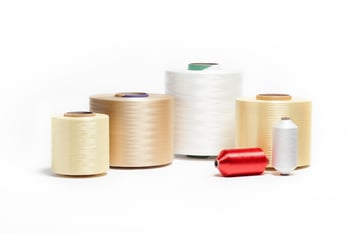 Industrial yarns and threads are made of various fiber types and sizes which aresupplied on a wide range of package sizes with different lengths and yields. Most products are ordered by the pound, which may leave you wondering, “How long is it?” It’s important to understand the length and yield of your products to help improve your processing efficiency and waste reduction.
Industrial yarns and threads are made of various fiber types and sizes which aresupplied on a wide range of package sizes with different lengths and yields. Most products are ordered by the pound, which may leave you wondering, “How long is it?” It’s important to understand the length and yield of your products to help improve your processing efficiency and waste reduction.
Length of a package can be critical if you are making a specific amount of material and you don’t want your yarn packages to run out prematurely. Plus, what if you end up with 1.5 pounds left over at the end of a production run? How do you know the length?
Service Thread is here to answer these questions and clarify how to estimate the yield and length of the thread packages you order. Here’s how it works.
Why Does Length Matter?
Length matters when it comes to maintaining an efficient and reliable production process. Accurate estimates allow you to allot time, manpower, and materials in a consistent way.
If you’re making hoses or cables, you’ll need specific unbroken lengths of material. You’ll also want to minimize waste while ensuring that your packages can be divided up to maximize yield.
When length and weight aren’t monitored, your yarn packages can easily fall out of balance and cause vibration during the run. This is especially true for partial packages. You’ll need to know the exact individual package amounts to keep the load balanced.
Denier vs. Cotton Count
Estimating yield and length all comes down to denier and cotton count, which are two methods of measuring yarns and threads. Which measurement you use depends on which type of material you have.
Filament yarns are measured in denier (DN), this is a Direct Measure. It’s the most common way of measuring filaments used for industrial hoses, wires, and cables.
Denier is a weight measurement of the linear density in grams per 9000 meters. Yarn with a higher denier has more mass per unit length than one with a lower denier. If you have two yarns made of the same material, a higher denier means it’s a larger yarn size. There are 4,464,528 yds/lb in 1 denier, therefore:
4,464,528 / denier size = yards/lb of material
Spun yarns are measured in cotton count (NeC), this is an Indirect Measure. This is how you’d measure spun yards used for the pull string on a dog food bag, for example.
Cotton count expresses the number of 840 yard lengths of material in one pound. Or, to put it another way, it looks at one pound of the material and describes how many 840-yard lengths of spun fiber it contains.
Cotton count indicates that the weight of the yarn is fixed and the length of material is determined. Larger cotton count numbers correspond to smaller sizes. Since there are 840 yds/lb in a Ne 1 yarn, this means:
840 x Cotton Count (NeC) = yards/lb of material
It’s easy to convert between denier size and cotton count by using the following formulas:
Denier = 5315/NeC
NeC = 5315/Denier
Calculating Yield
Yield is calculated by using the linear density/count of the material to determine the length of material found in a specific weight. For example, there are approximately 4,464 yds/lb of material in 1000DN.
Remember, yield is merely an estimate based on the available information. The yield estimation gives you a good idea of how much material you need or how much you have remaining based on the weight of the product. Most fiber producers operate within a yarn size tolerance so the true yield can fluctuate slightly.
For more information about selecting an industrial yarn and thread with the right yield and length for your manufacturing process, take a look at our blog, our helpful videos, or connect with Service Thread for expert assistance.



